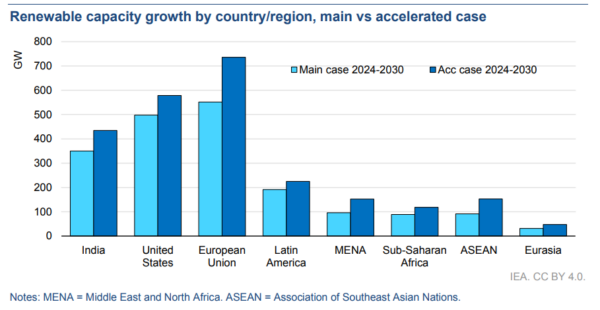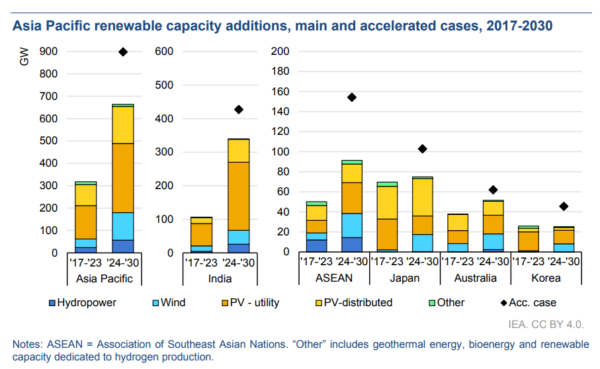A new report by IEA expects India’s annual renewable capacity additions to increase more quickly than for any other major economy over 2024-30, including China. The nation’s annual RE capacity additions will more than quadruple from 15 GW in 2023 to 62 GW in 2030.
The report states that India will almost triple its 2022 renewable capacity (from solar PV, wind, hydro and other RE resources) by 2030, in line with the COP28 global tripling pledge. Adding 350 GW over 2024-30, more than triple the previous six-year period, it will maintain third place among the largest renewable energy markets. Utility-scale PV will lead India’s RE growth with a 60% share, followed by distributed PV at 20%.

“In India, the rapid expansion of auctions, the introduction of a new support scheme for rooftop PV and stronger financial indicators for many utility companies make the country the fastest-growing renewable energy market among large economies through 2030,” states the report.
The report projects even higher RE growth for India in the accelerated case where the government addresses some challenges impacting RE deployment.

“India’s renewable capacity growth could be 24% higher if the government addresses land procurement barriers and lengthy grid connection wait times, which limit the expansion of utility-scale projects; weak financial health of distribution companies, which slows the pace of distributed solar PV growth; and relatively slow solar PV manufacturing expansion and restrictive trade measures, which limit the availability of affordable top-tier PV modules,” states the IEA report.
Competitive auctions continue to be the main driver for large-scale project development in India, with a record 33 GW of capacity awarded in the first half of 2024 – almost 50% more than in the whole of 2023. This year, a 40% share of capacity was awarded to hybrid systems, which combine PV, wind and storage technologies to reduce generation variability and facilitate system integration.
The report expects continuous policy support and greater project development activity to put India on track to meet its national target of 500 GW of non-fossil-based capacity by 2030.
This content is protected by copyright and may not be reused. If you want to cooperate with us and would like to reuse some of our content, please contact: editors@pv-magazine.com.









This is exciting news for India and the global renewable energy landscape! Being the fastest-growing renewable energy market among large economies highlights India’s commitment to sustainability and addressing climate change. The potential for innovation and job creation in this sector is enormous. I’m curious to see how this growth will impact energy policies and investment in technology moving forward. What are your thoughts on the challenges India might face in achieving these goals?
Applebee’s Long Island Iced Tea is a popular cocktail featuring a mix of vodka, rum, gin, tequila, triple sec, and sweet and sour mix, topped with cola for a refreshing, flavorful drink